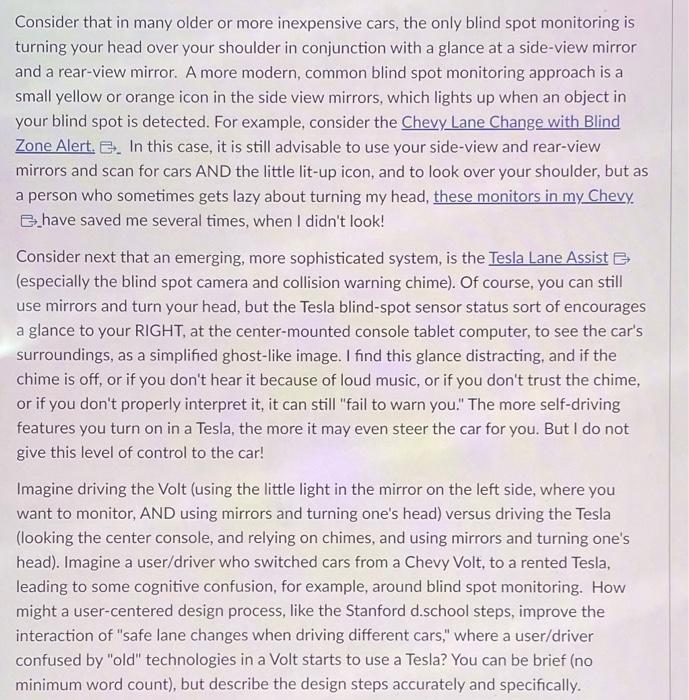Answered step by step
Verified Expert Solution
Question
1 Approved Answer
Consider that in many older or more inexpensive cars, the only blind spot monitoring is turning your head over your shoulder in conjunction with

Consider that in many older or more inexpensive cars, the only blind spot monitoring is turning your head over your shoulder in conjunction with a glance at a side-view mirror and a rear-view mirror. A more modern, common blind spot monitoring approach is a small yellow or orange icon in the side view mirrors, which lights up when an object in your blind spot is detected. For example, consider the Chevy Lane Change with Blind Zone Alert. . In this case, it is still advisable to use your side-view and rear-view mirrors and scan for cars AND the little lit-up icon, and to look over your shoulder, but as a person who sometimes gets lazy about turning my head, these monitors in my Chevy. have saved me several times, when I didn't look! Consider next that an emerging, more sophisticated system, is the Tesla Lane Assist (especially the blind spot camera and collision warning chime). Of course, you can still use mirrors and turn your head, but the Tesla blind-spot sensor status sort of encourages a glance to your RIGHT, at the center-mounted console tablet computer, to see the car's surroundings, as a simplified ghost-like image. I find this glance distracting, and if the chime is off, or if you don't hear it because of loud music, or if you don't trust the chime, or if you don't properly interpret it, it can still "fail to warn you." The more self-driving features you turn on in a Tesla, the more it may even steer the car for you. But I do not give this level of control to the car! Imagine driving the Volt (using the little light in the mirror on the left side, where you want to monitor, AND using mirrors and turning one's head) versus driving the Tesla (looking the center console, and relying on chimes, and using mirrors and turning one's head). Imagine a user/driver who switched cars from a Chevy Volt, to a rented Tesla, leading to some cognitive confusion, for example, around blind spot monitoring. How might a user-centered design process, like the Stanford d.school steps, improve the interaction of "safe lane changes when driving different cars," where a user/driver confused by "old" technologies in a Volt starts to use a Tesla? You can be brief (no minimum word count), but describe the design steps accurately and specifically.
Step by Step Solution
★★★★★
3.52 Rating (162 Votes )
There are 3 Steps involved in it
Step: 1
The Stanford dschool steps would involve the following 1 Empathize Spend time with users and observe them using both the Chevy Volt and the Tesla Identify their frustrations and needs when using the t...
Get Instant Access to Expert-Tailored Solutions
See step-by-step solutions with expert insights and AI powered tools for academic success
Step: 2

Step: 3

Ace Your Homework with AI
Get the answers you need in no time with our AI-driven, step-by-step assistance
Get Started


